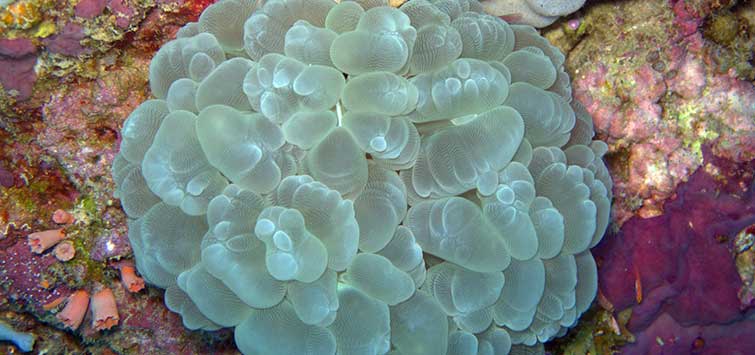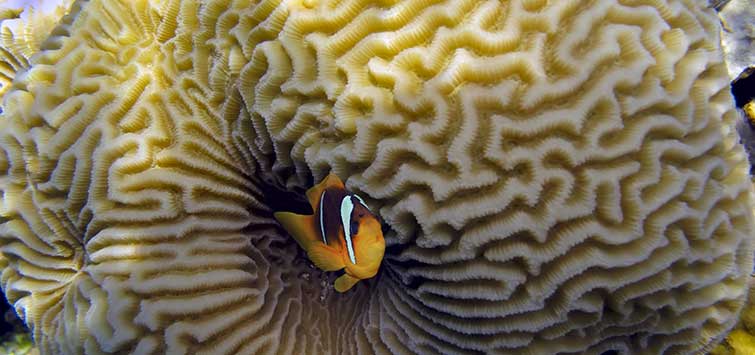Give Your Mini-Reef a Bit of the Bubbly
Author: Jeff Kurtz
Mini-reef aquarists typically start out keeping an assortment of hardy soft corals, such as leather corals, mushroom anemones, pulse corals, and zoanthid polyps. But eventually the desire to keep the more challenging stony corals proves too powerful for most aquarists to resist. Fortunately, there are several species of large-polyp stony (LPS) coral that are tough enough to thrive under the novice reefkeeper’s care and so make excellent choices for that first foray into stony-coral keeping. One of the best choices among these species is the bubble coral Plerogyra sinuosa, also known as the bladder coral, pearl coral, or grape coral.
Bubble Corals
You may see other Plerogyra or Physogyra species also sold as “bubble corals.” However, since their care requirements don’t depart significantly from those of P. sinuosa, you can safely assume that most of what is discussed here applies to those species as well.
What’s so special about the bubble coral? It has many of the characteristics that reef aquarists look for in a coral. It’s beautiful and exotic looking. It’s relatively fast-growing. It can adapt to a fairly wide range of aquarium conditions. And it’s remarkably resilient in spite of its delicate appearance.
Physical Characteristics
The tentacles of P. sinuosa are modified into bubble- or grape-shaped vesicles that typically remain expanded during the day and contract at night. Depending on the specimen (and, of course, the lighting under which they’re kept), the vesicles may be white, brown, bluish gray, green, or fawn colored. Many are adorned with an attractive “fingerprint” pattern.
Once the lights go out and the vesicles contract (into a surprisingly compact package, I might add), longer “sweeper” tentacles armed with stinging nematocysts emerge from the coral to facilitate feeding and to keep neighboring coral colonies from encroaching.
The skeleton, which is almost totally obscured when the bubbles are inflated, has sharp, blade-like septa lining the top edge. The vesicles are attached directly to these septa. Due to the bubble coral’s irregularly shaped skeleton, it can be a bit of a challenge to find a place on the mini-reef where the specimen can be nestled firmly.
Keep in mind that the bubble coral, which is rather top-heavy when inflated, should be placed in an area where it won’t take a tumble, and in such a way that its vesicles don’t chafe against the live rock. It may be necessary to rearrange your rockwork a bit in order to create the perfect niche.
It Takes a Licking…
I can personally attest to the bubble coral’s toughness. Once, when scraping the coralline algae from the front glass of my reef tank (arm fully submerged with a razor blade clenched firmly between my thumb and forefinger), I unintentionally created a surge through the motion of my arm and hand that caused my top-heavy bubble coral to tumble end over end down the face of the rockwork and onto the substrate, where it landed upside down.
After swallowing my heart and uttering a few choice words not suitable for printing here, I retrieved the coral by its skeleton and put it back in place, fearing it had sustained irreparable damage. To my relief, the vesicles were completely re-expanded within a few hours, and it looked none the worse for wear.
…But Don’t Push Your Luck!
This is not to suggest that bubble corals will always survive such abuse. If handled too roughly during collection, transport, or introduction to the aquarium, the tissue can be lacerated on the sharp septa, leaving the animal vulnerable to bacterial or protozoan infection. For this reason, you should always examine a bubble coral specimen carefully for evidence of tissue damage before purchasing it.
If you’d prefer to eliminate any possibility of your bubble coral taking a spill and damaging its tissues, I would suggest placing it on the very bottom of the tank with its skeleton partially buried in the substrate. However, avoid placing it in a bottom location where detritus tends to accumulate.
If you have a sandy substrate, try to avoid placing your specimen where sand can drift onto its tissues. If you notice that sand or other debris has settled on your specimen, you can very gently lift the coral, handling it by its skeleton, and carefully invert it so the particles become dislodged before putting the specimen back in its place.
Placement in the Tank
Because P. sinuosa is found in both turbid and brightly illuminated areas in nature, it can adapt to a relatively wide range of lighting conditions in the aquarium. This means you can place it at just about any level in the tank. I kept a specimen in a 75-gallon reef tank approximately two-thirds of the way up the rockwork beneath power compact fluorescent lighting, and it did perfectly well there for several years. But this coral will do just fine under other lighting schemes as well.
Just take care to avoid shocking a specimen by exposing it to too much light right off the bat, especially if your lighting system includes metal halides. It’s a good idea to place your bubble coral lower in the tank to begin with, and then move it upward gradually (if desired) so that it has a chance to adjust to the specific lighting conditions in your tank.
Sweeper Tentacles
The aforementioned sweeper tentacles are an important consideration when choosing a location in your mini-reef for a bubble coral. They may not be as long as the sweeper tentacles of, say, an elegance coral, but they still pack a powerful wallop and will irritate or injure any invertebrate that is placed too close. I would suggest leaving approximately 5 or 6 inches between your bubble coral and other specimens—perhaps a bit closer on the up-current side of the bubble coral.
If you notice a neighboring specimen that refuses to extend its polyps, or if you see tissue damage on the side of it that’s facing the bubble coral, it may be getting stung at night and it (or the bubble coral) should be moved to a less volatile location.
Water Movement
Bubble corals also appreciate a moderate amount of water movement. By “moderate” I mean it should get just enough turbulent current so that its vesicles sway and jiggle gently on a continuous basis, keeping them free of debris. Don’t blast your bubble coral directly with a powerhead or the vesicles will deflate and refuse to open until things settle down.
Feeding
P. sinuosa is a photosynthetic coral—i.e., it gets much of the nutrients it needs for survival from the symbiotic algae, called zooxanthellae, residing in its tissues. It’s also able to inflate or deflate its “bubbles” in response to varying light levels. So, for example, in lower light conditions, it can expand its vesicles in order to expose more surface area, and hence more zooxanthellae, to the light.
However, bubble corals appreciate occasional direct feeding and will grow much more rapidly if they don’t have to rely on light alone. In fact, I’ve found that a specimen will thrive and multiply in size with weekly direct feedings of mysid or brine shrimp. Simply thaw out a small amount in aquarium water and, using a turkey baster or pipette (like the ones that come with aquarium test kits), gently squirt the shrimp directly onto the bubble coral’s vesicles. Or you can place a small chunk of chopped seafood amidst the vesicles with your fingers.
Very slowly, almost imperceptibly, you’ll see the cluster of vesicles part down the middle, revealing the now-open mouth (or mouths, as the case may be). The mouth will then draw in the food item and then close just as slowly around it. It’s really an awesome sight to behold!
More Food Options
Other foods that you might want to offer your bubble coral include chopped clams or scallops, chopped shrimp, bits of fish, or any other meaty seafood items. Just try to avoid overdoing it when feeding. I’ve noticed that a specimen will regurgitate the whole wad of food if given too much at one time. Whether that applies to all bubble corals or not, I can’t say, but moderation in feeding is always recommended to maintain the excellent water quality necessary for the captive maintenance of corals.
Danger Signs
Expanding Vesicles
A bubble coral that is unhappy with its water conditions will refuse to expand its vesicles during daylight hours. If this should occur, test all of your water parameters to see what has gone wrong and correct the problem promptly. Also, on a regular basis, examine your specimen to make sure the vesicles are not detaching from the septa, which is a more drastic indicator that either your water quality is suffering or the coral is being deprived of an element it needs for proper tissue growth.
As with other large-polyp stony corals, the exposed skeletons of bubble corals seem to be a magnet for algae growth. In fact, one specimen that I purchased had clumps of green filamentous algae clinging to its skeleton but hidden by the expanded vesicles. Unfortunately, this escaped my scrutiny at the aquarium store—probably because, in my excitement over this beautiful specimen, I didn’t follow my own advice of very thoroughly examining a specimen before purchasing it. Had I looked more closely when my dealer was bagging the specimen, at which time the vesicles were fully deflated, I would have observed the algae.
Algae Overgrowth
If allowed to grow unchecked, algae can irritate the polyps and, if conditions are conducive, eventually spread to the point that it smothers the coral. So, to prevent this, I pulled a little bit of algae off the skeleton each night by hand after the coral contracted, taking great care to avoid damaging its tissues in the process, and eventually I was able to eliminate all of it. Of course, it also helped that I was keeping the dissolved nutrients in the aquarium to a minimum through frequent water changes and the use of a good protein skimmer.
Remember the Essentials
These few danger signs aside, there aren’t many problems that will afflict a healthy bubble coral. Just be sure to give your specimen outstanding water quality, supplemental feedings, and plenty of room in your tank to accommodate growth. Provide these essentials, and you’ll be amazed at how rapidly your bubble coral will expand to fill up the space.
See the full article on TFH Digital http://www.tfhdigital.com/tfh/200712/#pg112

.png?h=595&iar=0&w=2781&hash=5FD5E69473BCC22199FBFA2FB71B6033)



